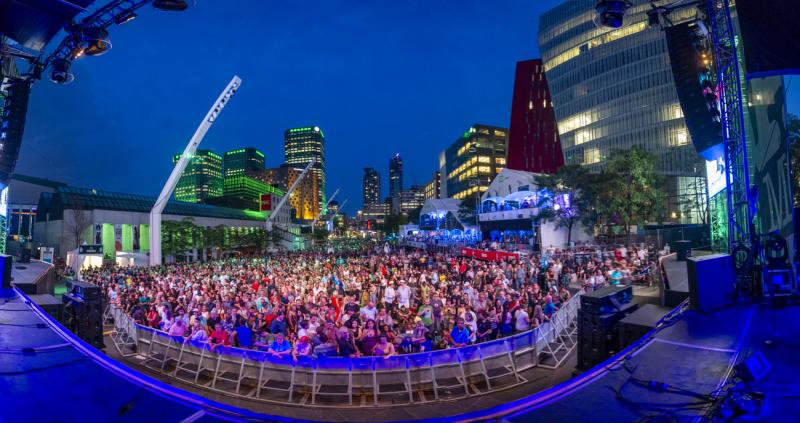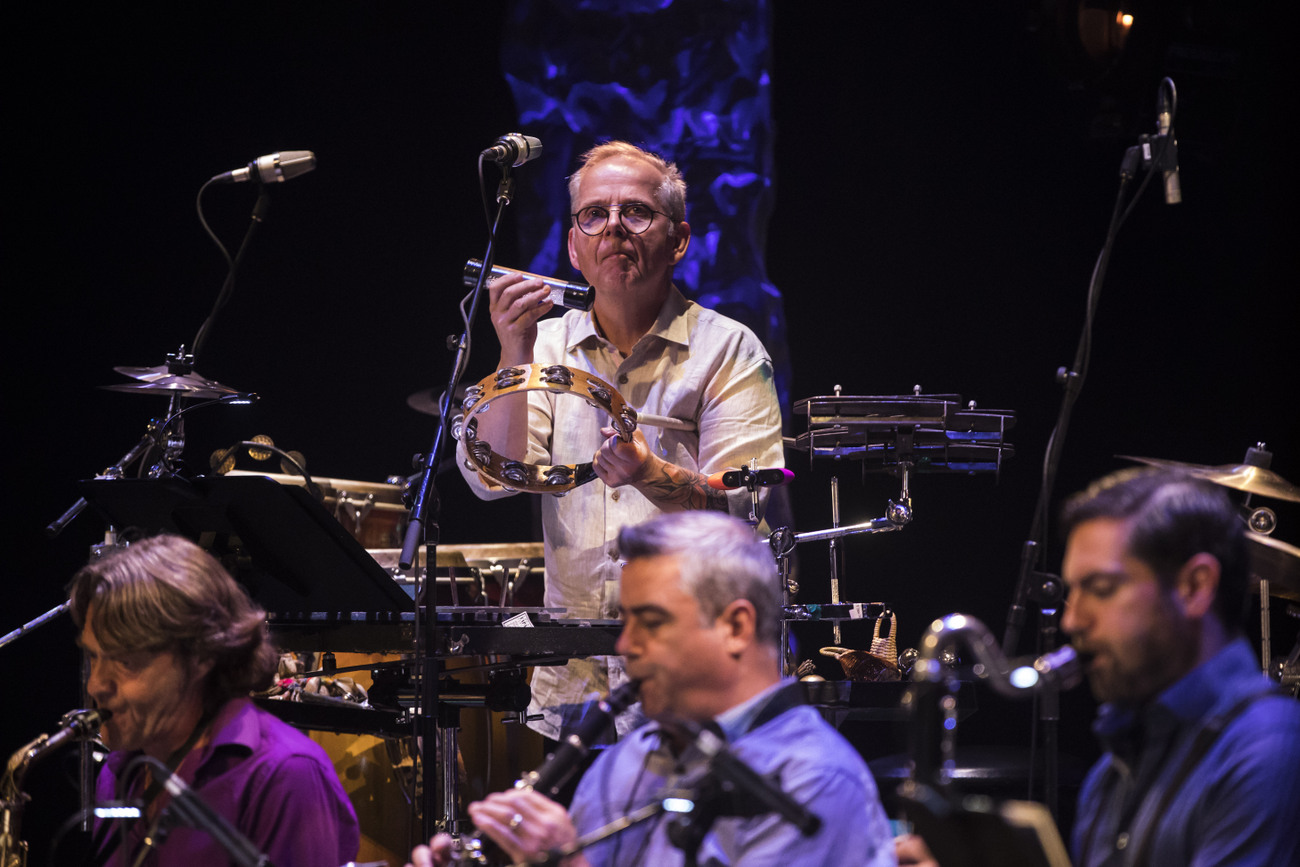theartsdesk at the Montreal International Jazz Festival - fabulous at 40 | reviews, news & interviews
theartsdesk at the Montreal International Jazz Festival - fabulous at 40
theartsdesk at the Montreal International Jazz Festival - fabulous at 40
A vast celebration with a unique vibe

The Montreal Jazz Festival is vast. It attracts an audience of between 1.5 and 2 million people over its 12 nights. It has been estimated to bring the city more revenue than the Canadian Grand Prix.
And yet size, as we were often reminded in this year's 40th edition of the festival, is not everything. The festival has been an increasingly powerful vindication of its co-founders’ original vision which dates from the heady idealistic days when Montreal was thinking really big: in 1980, the year of the first festival, there had been the Expo and the Olympics; it was also the year of the referendum. Alain Simard and André Ménard were convinced that music and the summer vibe could bring different communities together in what is often called the friendliest city in North America. What they have achieved in partnership with the city, and trusting in the power of the music and the character of the Montréalais, is remarkable and unique. (Pictured below: the daily "children's camp" at the festival, photograph by Alexanne Brisson/FIJM) People in the city talk about “going to the festival” irrespective of who is actually playing or singing. They just head into town and to the free stages of the Quartier des Spectacles for a day out or for an evening’s bain de foule. One of the programming team had a self-deprecating if slightly mischievous take on this. Side-stepping a question at the wrap-up press conference as to what the equivocal phrase “being on budget financially” actually meant, he said: “The best programmer around here is the sun. And he really couldn’t have done better than he did this year.” In fact, ticketed concerts were 80 percent sold out. One bottled water company currently has a campaign about Montreal’s “effervescence” and – if one chooses to forget the ubiquitous roadworks – that is a pretty accurate word to describe the mood of the city and its inhabitants in the summer.
People in the city talk about “going to the festival” irrespective of who is actually playing or singing. They just head into town and to the free stages of the Quartier des Spectacles for a day out or for an evening’s bain de foule. One of the programming team had a self-deprecating if slightly mischievous take on this. Side-stepping a question at the wrap-up press conference as to what the equivocal phrase “being on budget financially” actually meant, he said: “The best programmer around here is the sun. And he really couldn’t have done better than he did this year.” In fact, ticketed concerts were 80 percent sold out. One bottled water company currently has a campaign about Montreal’s “effervescence” and – if one chooses to forget the ubiquitous roadworks – that is a pretty accurate word to describe the mood of the city and its inhabitants in the summer.
The events on the biggest of the outdoor stages on the final two nights – the area in front of the TD stage can take up to 60,000 people – were not exactly jazz acts, but what they did show was the life, energy and variety of the Montreal music scene. Jordan Officer, the free-stage headliner on the last Friday, is a popular, charismatic and adaptable singer/guitarist from the city who is comfortable across the whole jazz/blues/ country spectrum and had successfully plotted a particularly upbeat show, with a strong and tight nine-piece band. For the final Saturday, the headliner was Matt Holubowski, a finalist in the 2015 Quebec version of The Voice. His introspective vibe was more challenging, but he held the vast crowd’s attention nonetheless. On the theme of local heroes, another successful show which was running in several performances throughout the festival was a multi-media spectacle devised by Arcade Fire mainstay Richard Reed Parry.
While some jazz people will always intone the familiar lament that there isn’t that much jazz at jazz festivals, for Montreal one can forget that argument: the sheer scale of MIJF and the variety of musicians on offer renders such criticisms laughable; this is a feast of jazz. The opening act was French accordionist Richard Galliano in a duo with bass legend Ron Carter. There were major shows by Steve Gadd, Christian Scott, Stacey Kent, and an ECM 50th anniversary celebration with Tord Gustafson, Larry Grenadier, Bobo Stenson and the duo of Vijay Iyer and Craig Taborn. There was a let’s-see-what-happens kind of gig, a genuine one-off from the duo of singer Kurt Elling and pianist Danilo Perez
Great little clubs like Upstairs and Dièse Onze have top acts. The Lion d’Or art deco cabaret room, which has somehow, miraculously dodged the attentions of Montreal’s ever-busy demolition industry for 89 years, was used by the festival for the first time this year and welcomed fine singer Holly Cole. The local scene’s strong representation begins each day at 11am with a Petite École for kids. At the other end of the age scale, veteran pianist Wray Downes was honoured with both the Oscar Peterson Award and a trio concert. Fine jazz musicians from the city can be heard in more or less ideal circumstances. This was particularly the case for saxophonist and composer Christine Jensen (pictured above right with Helen Sung, photo by Alexanne Brisson/FIJM). She had been given carte blanche to invite whomever she wanted, and the debut concert of her quartet with three adoptive New Yorkers (pianist Helen Sung, bassist Noriko Ueda and drummer Allison Miller) was phenomenal, and Sung’s piano playing never short of dazzling. Drummer Jim Doxas (from Dave Douglas’s Riverside band) is another local hero, and his quartet album launch, at which he generously offered a free CD to everyone present was remarkable in that it took the line-up of the classic Ornette Coleman quartets, and produced a language that was much more measured, folk-inspired, tranquil and Nordic, and brought to the fore a trumpeter from New Zealand about whom there is a real musician buzz in Montreal: Lex French.
Fine jazz musicians from the city can be heard in more or less ideal circumstances. This was particularly the case for saxophonist and composer Christine Jensen (pictured above right with Helen Sung, photo by Alexanne Brisson/FIJM). She had been given carte blanche to invite whomever she wanted, and the debut concert of her quartet with three adoptive New Yorkers (pianist Helen Sung, bassist Noriko Ueda and drummer Allison Miller) was phenomenal, and Sung’s piano playing never short of dazzling. Drummer Jim Doxas (from Dave Douglas’s Riverside band) is another local hero, and his quartet album launch, at which he generously offered a free CD to everyone present was remarkable in that it took the line-up of the classic Ornette Coleman quartets, and produced a language that was much more measured, folk-inspired, tranquil and Nordic, and brought to the fore a trumpeter from New Zealand about whom there is a real musician buzz in Montreal: Lex French.
A genuine jazz highlight was the concert by the Joshua Redman Quartet with Aaron Goldberg, Reuben Rogers and Greg Hutchinson. They played the 1450-seater Théâtre Maisonneuve. This band was busy and successful from 1998 to 2002. Re-formed in 2014, it is now one of the great jazz groups in the world. All four members were absolutely at the top of their game as individuals. For a demonstration of how each member of a band can spur on the others and instil devil-may-care energy, this was a concert to remember.  I was less convinced by the Orchestre National de Jazz de Montreal’s mainly instrumental tribute to Dr Dre, but the crowd loved it. And the programme did bring to the fore the sheer quality and strength in depth of the pool of jazz talent in Montreal: Jean-Pierre Zanella is surely one of the world’s great big band lead alto saxophonists, and it is not difficult to understand why septuagenarian local hero Luc Boivin is such a legend in Montreal music circles (pictured above by Frédérique Ménard-Aubin /MIJF)
I was less convinced by the Orchestre National de Jazz de Montreal’s mainly instrumental tribute to Dr Dre, but the crowd loved it. And the programme did bring to the fore the sheer quality and strength in depth of the pool of jazz talent in Montreal: Jean-Pierre Zanella is surely one of the world’s great big band lead alto saxophonists, and it is not difficult to understand why septuagenarian local hero Luc Boivin is such a legend in Montreal music circles (pictured above by Frédérique Ménard-Aubin /MIJF)
The things that one misses serve as a reminder of the sheer scale of the festival. In truth, no individual can possibly see more than a small part of it. This year the organisers made the task harder by bringing the festival vibe into the suburbs. There was a stage with six and a half hours of music every day quite some distance from the central site, in the Verdun district of the city. And even the sold-out concert by Bryan Adams at the festival’s largest ticketed space, the 21,000-seater Bell hockey arena, seemed mostly to avoid critical attention.
The Montreal programmers are fans of the UK music scene and know it well. Chvrches were there. Peter Frampton on his farewell tour had the crowd in ecstasy from his opener "Baby (Somethin’s Happening)", and went on building the love from there. And the young UK jazz scene was well represented with shows by Nubya Garcia and Jacob Collier. Tuba player Theon Cross, as is his way, created some real excitement and a lot of new fans. He was one of the most talked-about artists of the festival.
And yet, this year, with the departure of co-founder André Ménard, there was much self-reflection about what makes this vast festival unique. Joshua Redman commented that he really couldn't imagine the festival without Ménard, and Richard Galliano described him as "the soul of the festival." Ménard’s formal departure, which was marked notably by a “40 years of memories” evening, was a highly emotional occasion, rich with stories about, for example, Chet Baker and Charlie Haden. Ménard is one of the most voracious music fans anywhere. His succession is now well in place, but his jovial and benign presence at the heart of it all, his sense of the history and the part he has played in making it, will all be missed.
The future of Arts Journalism
You can stop theartsdesk.com closing!
We urgently need financing to survive. Our fundraising drive has thus far raised £49,000 but we need to reach £100,000 or we will be forced to close. Please contribute here: https://gofund.me/c3f6033d
And if you can forward this information to anyone who might assist, we’d be grateful.

Subscribe to theartsdesk.com
Thank you for continuing to read our work on theartsdesk.com. For unlimited access to every article in its entirety, including our archive of more than 15,000 pieces, we're asking for £5 per month or £40 per year. We feel it's a very good deal, and hope you do too.
To take a subscription now simply click here.
And if you're looking for that extra gift for a friend or family member, why not treat them to a theartsdesk.com gift subscription?
more New music
 Album: Night Tapes - portals//polarities
Estonian-voiced, London-based electro-popsters debut album marks them as one to watch for
Album: Night Tapes - portals//polarities
Estonian-voiced, London-based electro-popsters debut album marks them as one to watch for
 Album: Mulatu Astatke - Mulatu Plays Mulatu
An album full of life, coinciding with a 'farewell tour'
Album: Mulatu Astatke - Mulatu Plays Mulatu
An album full of life, coinciding with a 'farewell tour'
 Music Reissues Weekly: Sly and the Family Stone - The First Family: Live At Winchester Cathedral 1967
Must-have, first-ever release of the earliest document of the legendary soul outfit
Music Reissues Weekly: Sly and the Family Stone - The First Family: Live At Winchester Cathedral 1967
Must-have, first-ever release of the earliest document of the legendary soul outfit
 Album: Robert Plant - Saving Grace
Mellow delight from former Zep lead
Album: Robert Plant - Saving Grace
Mellow delight from former Zep lead
 Brìghde Chaimbeul, Round Chapel review - enchantment in East London
Inscrutable purveyor of experimental Celtic music summons creepiness and intensity
Brìghde Chaimbeul, Round Chapel review - enchantment in East London
Inscrutable purveyor of experimental Celtic music summons creepiness and intensity
 Album: NewDad - Altar
The hard-gigging trio yearns for old Ireland – and blasts music biz exploitation
Album: NewDad - Altar
The hard-gigging trio yearns for old Ireland – and blasts music biz exploitation
 First Person: Musician ALA.NI on how thoughts of empire and reparation influenced a song
She usually sings about affairs of the heart - 'TIEF' is different, explains the star
First Person: Musician ALA.NI on how thoughts of empire and reparation influenced a song
She usually sings about affairs of the heart - 'TIEF' is different, explains the star
 Album: The Divine Comedy - Rainy Sunday Afternoon
Neil Hannon takes stock, and the result will certainly keep his existing crowd happy
Album: The Divine Comedy - Rainy Sunday Afternoon
Neil Hannon takes stock, and the result will certainly keep his existing crowd happy
 Music Reissues Weekly: Robyn - Robyn 20th-Anniversary Edition
Landmark Swedish pop album hits shops one more time
Music Reissues Weekly: Robyn - Robyn 20th-Anniversary Edition
Landmark Swedish pop album hits shops one more time
 Album: Twenty One Pilots - Breach
Ohio mainstream superstar duo wrap up their 10 year narrative
Album: Twenty One Pilots - Breach
Ohio mainstream superstar duo wrap up their 10 year narrative
 Album: Ed Sheeran - Play
A mound of ear displeasure to add to the global superstar's already gigantic stockpile
Album: Ed Sheeran - Play
A mound of ear displeasure to add to the global superstar's already gigantic stockpile
 Album: Motion City Soundtrack - The Same Old Wasted Wonderful World
A solid return for the emo veterans
Album: Motion City Soundtrack - The Same Old Wasted Wonderful World
A solid return for the emo veterans

Add comment